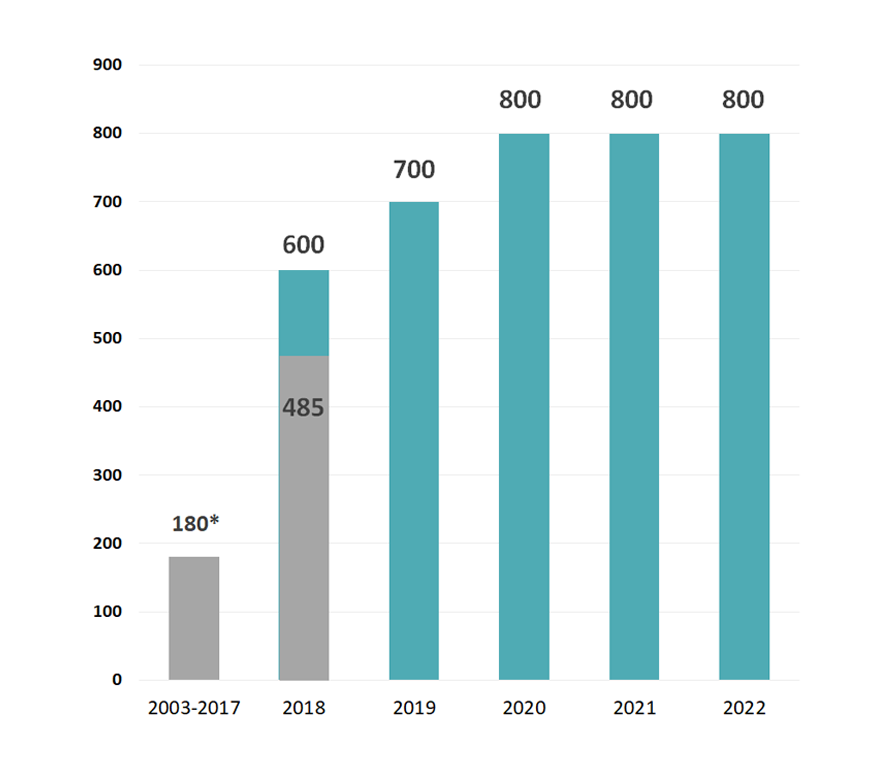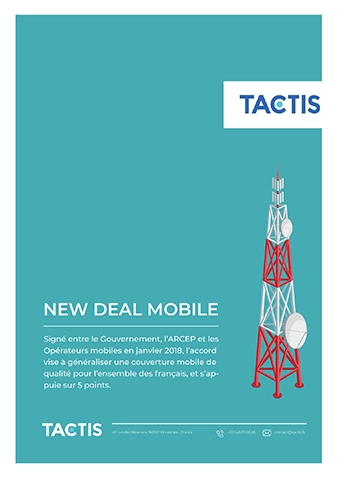WHAT IS THE NEW MOBILE DEAL?
Signed between the Government, Arcep, and mobile operators in January 2018, this historic agreement aims to generalize quality mobile coverage for all French people, and is based on five commitments made by the operators.
THE 5 COMMITMENTS MADE BY THE OPERATORS
In January 2018, Arcep and the Government presented the five commitments made by mobile operators to accelerate mobile coverage in the regions. These commitments were incorporated into their frequency usage authorizations for the four mobile operators (Bouygues Telecom, Free Mobile, Orange, and SFR) to make them legally enforceable.

Ensure quality mobile coverage in areas with no or poor coverage thanks to the "targeted coverage" system by building 5,000 new sites per operator, some of which will be shared

Generalize 4G across all mobile sites by the end of 2020, i.e. 10,000 municipalities (ZBCB Program: 75% by the end of 2020, 100% by the end of 2022)

Improve coverage of transport routes (priority roads and regional rail network)

Improve indoor coverage(Voice over Wi-Fi and on-demand coverage)

Offer a fixed 4G service in areas where fixed speeds are not satisfactory
Focus on: the targeted coverage mechanism at the heart of improving rural coverage
The targeted coverage mechanism of the New Deal Mobile is based on the commitment made by each operator to build coverage in 5,000 new areas per operator. This system is centered on the choices made by local authorities, organized around departmental or regional project teams.
The first part of the system aims to cover 2,000 dead zones, namely the most populated areas where no operator has good coverage. To this end, the operators have made proposals in an atlas they have implemented. The mobile sites concerned would then be shared.
The second part aims to cover 3,000 other gray areas resulting from proposals from local elected officials and priorities identified by the project teams. This concerns any type of location (e.g. inhabited areas, tourist locations, mountain areas, etc.).
Once these areas have been identified, they give rise to a State decree, leaving between 12 and 24 months for operators to carry out the work to cover the area.
This period depends on the municipality providing the operator with serviced land accompanied by planning permission. While between 2003 and 2017, only 180 new sites were built on average, the targeted coverage system provides for 600 to 800 new sites per year.
Mobile site deployment schedule

Representation of the rate of construction of pylons to cover the 5,000 zones from 2018, compared to the average annual number of mobile sites built in white zones between 2003 and 2017. From 2023, the rate will remain the same, up to 600 new sites per operator

Julien Renard
Comment tirer parti du New Deal Mobile ?
Tactis vous accompagne dans la mise en œuvre du dispositif de couverture ciblée du New Deal

Tactis accompagne les équipes projets dans le cadre de la mise en œuvre du New Deal, à travers 4 grands axes :
Modeling the radio coverage of the territory, in order to highlight areas with poorer coverage.
Analysis of coverage data and prioritization of areas to be covered, which must be reported back by the project teams.
Help in identifying the location of sites to ensure coverage of the areas to be covered.
Monitoring the project as a whole to ensure that the commitments made by the operators are respected.
In addition, Tactis also supports communities that wish to do so in defining field measurement protocols, whether these measurements are carried out by professionals (drive-tests), a wide audience (crowdsourcing) or a sample of people (through the purchase or loan of measurement equipment), and, where appropriate, throughout the public procurement procedure, up to the selection of the service provider.
Contact Julien Renard
Do you have a question about the New Deal Mobile? Need some clarification regarding a future project? Send an email to Julien Renard, a Tactis radio expert.


